An Analysis of Renewable Energy Economics in Australia
VerifiedAdded on 2021/06/18
|10
|1358
|34
Report
AI Summary
This report examines the economics of renewable energy in Australia, focusing on the interplay of demand, supply, and market equilibrium. It analyzes the impact of government policies, particularly those aimed at improving energy efficiency and promoting renewable sources. The report discusses the challenges of balancing energy demands with the shift towards renewable sources, including the influence of price variations and the role of demand-side responses. It highlights the importance of initiatives like energy-efficient building codes and appliance standards in managing electricity costs and reducing emissions. The analysis draws on an article from the Sydney Morning Herald and provides recommendations for future strategies, such as ambitious building codes and reviews of emission standards, to ensure a stable and sustainable energy market in Australia. The report concludes by emphasizing the potential cost savings and environmental benefits of these measures.
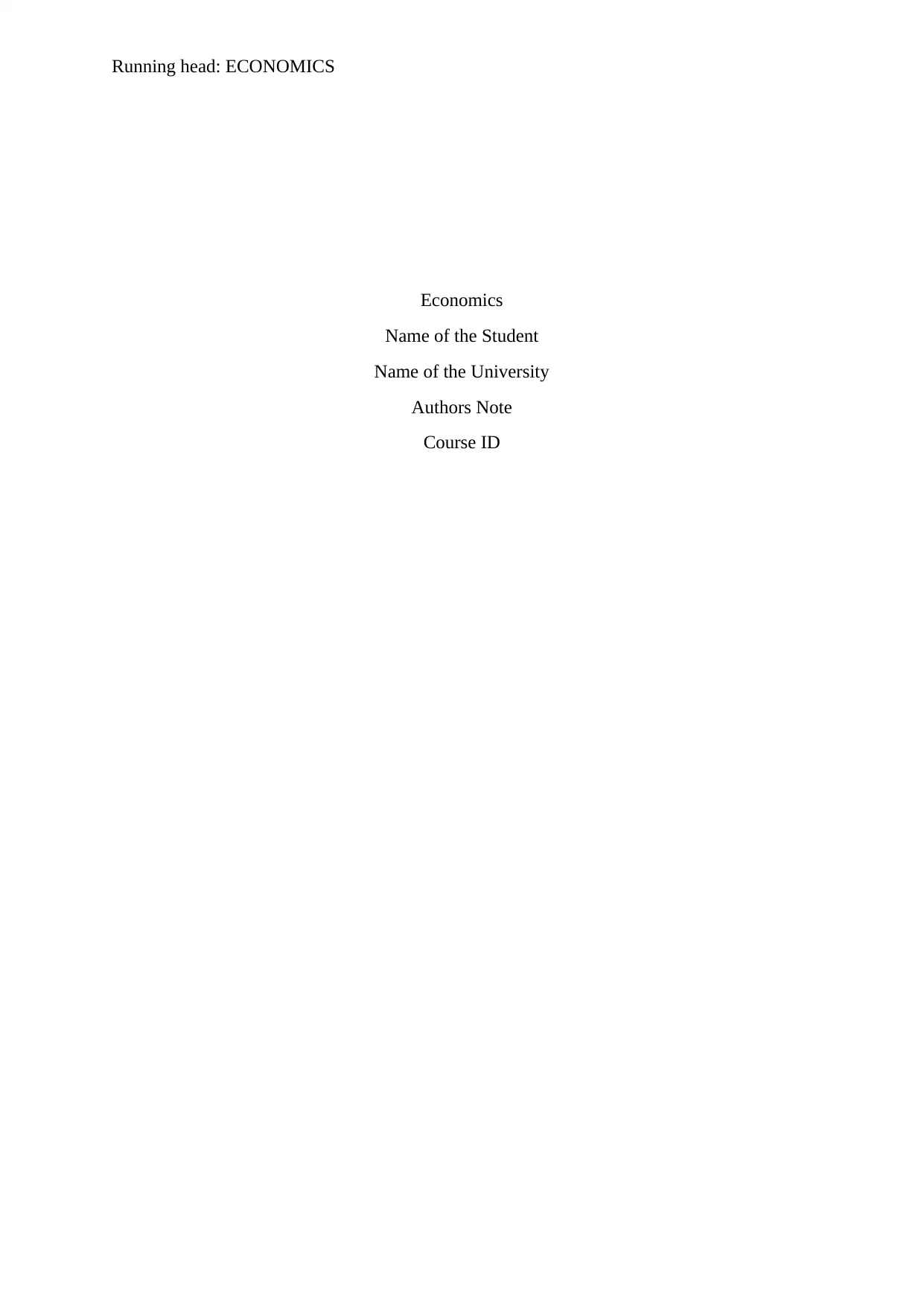
Running head: ECONOMICS
Economics
Name of the Student
Name of the University
Authors Note
Course ID
Economics
Name of the Student
Name of the University
Authors Note
Course ID
Paraphrase This Document
Need a fresh take? Get an instant paraphrase of this document with our AI Paraphraser
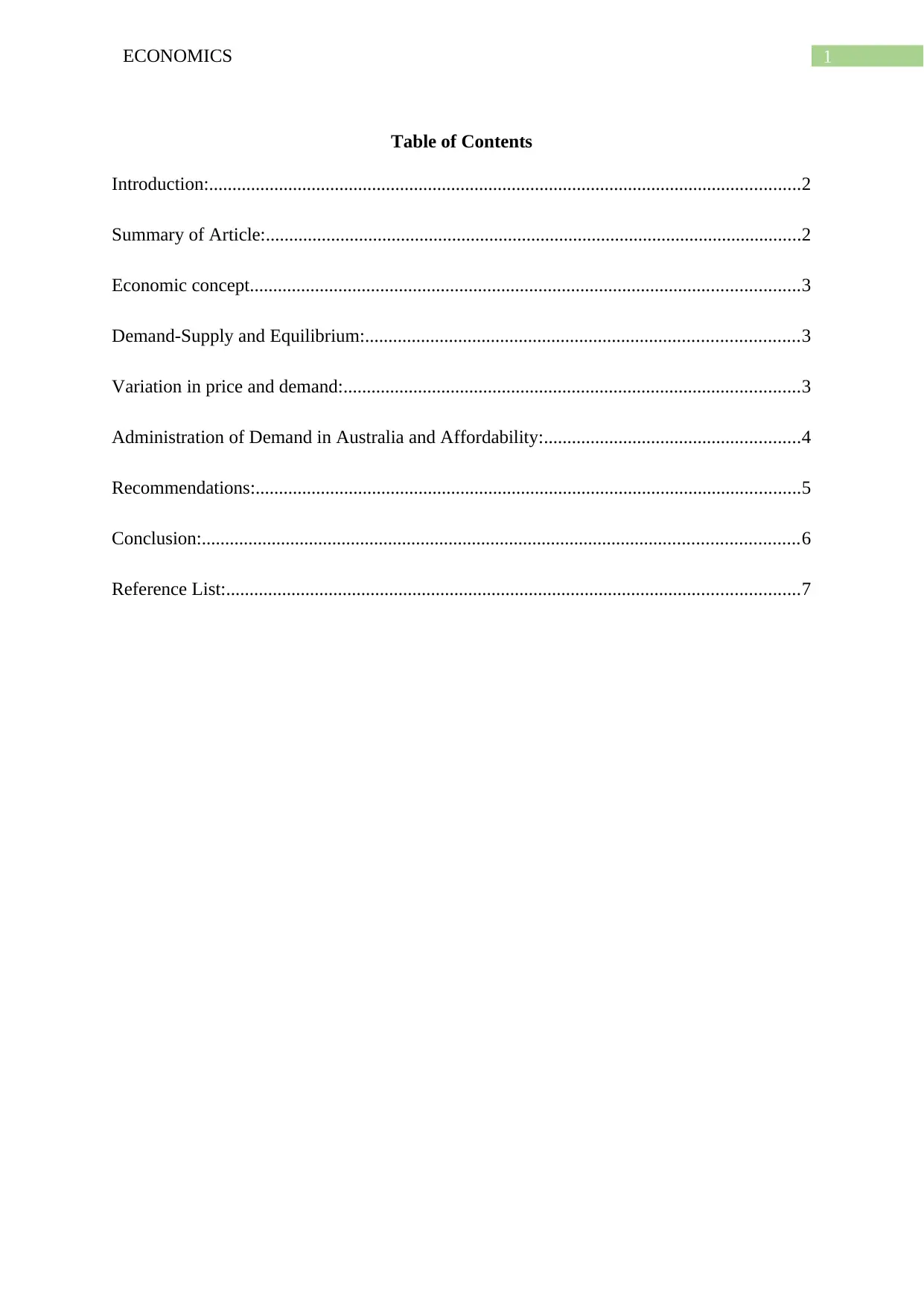
1ECONOMICS
Table of Contents
Introduction:...............................................................................................................................2
Summary of Article:...................................................................................................................2
Economic concept......................................................................................................................3
Demand-Supply and Equilibrium:.............................................................................................3
Variation in price and demand:..................................................................................................3
Administration of Demand in Australia and Affordability:.......................................................4
Recommendations:.....................................................................................................................5
Conclusion:................................................................................................................................6
Reference List:...........................................................................................................................7
Table of Contents
Introduction:...............................................................................................................................2
Summary of Article:...................................................................................................................2
Economic concept......................................................................................................................3
Demand-Supply and Equilibrium:.............................................................................................3
Variation in price and demand:..................................................................................................3
Administration of Demand in Australia and Affordability:.......................................................4
Recommendations:.....................................................................................................................5
Conclusion:................................................................................................................................6
Reference List:...........................................................................................................................7
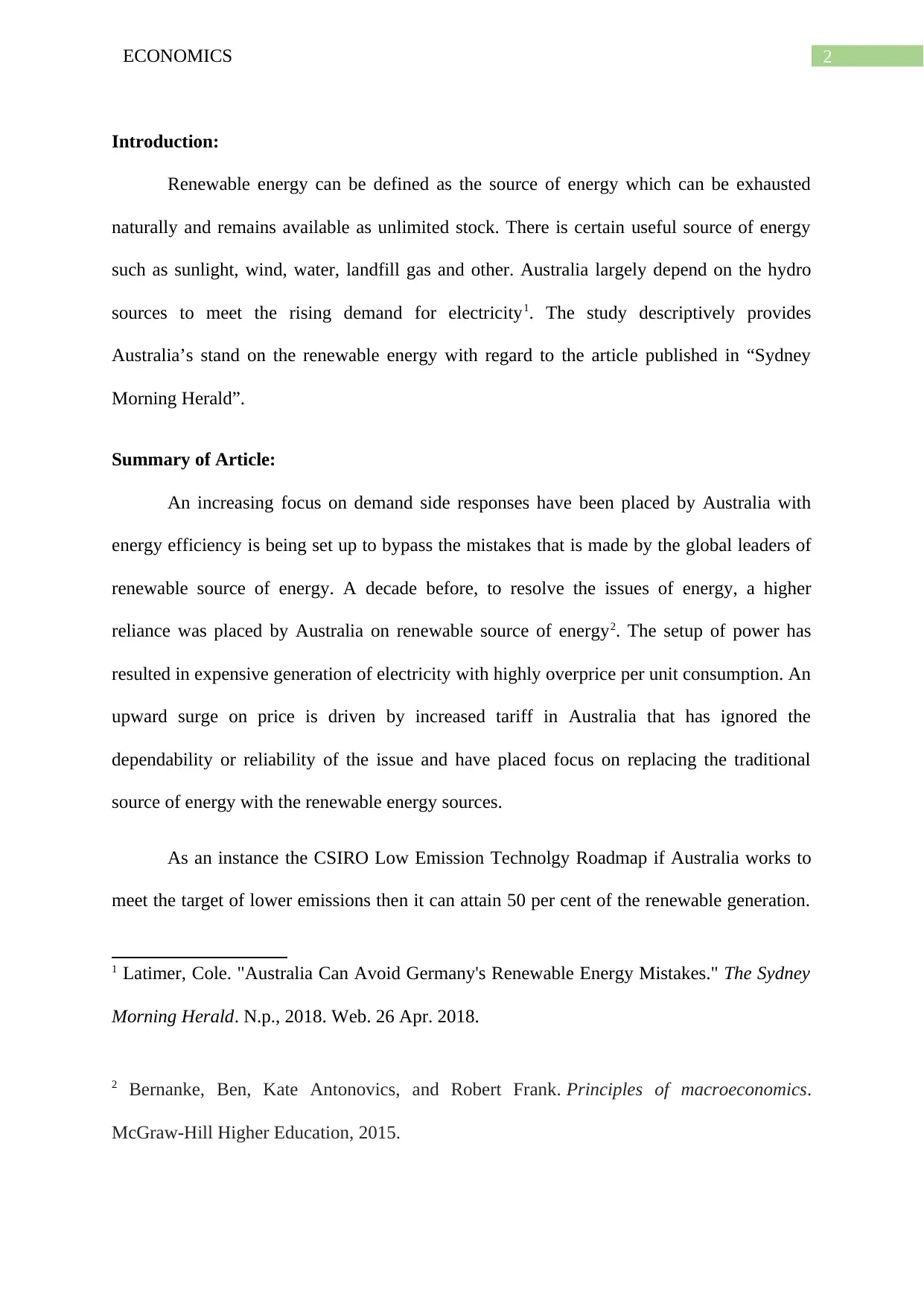
2ECONOMICS
Introduction:
Renewable energy can be defined as the source of energy which can be exhausted
naturally and remains available as unlimited stock. There is certain useful source of energy
such as sunlight, wind, water, landfill gas and other. Australia largely depend on the hydro
sources to meet the rising demand for electricity1. The study descriptively provides
Australia’s stand on the renewable energy with regard to the article published in “Sydney
Morning Herald”.
Summary of Article:
An increasing focus on demand side responses have been placed by Australia with
energy efficiency is being set up to bypass the mistakes that is made by the global leaders of
renewable source of energy. A decade before, to resolve the issues of energy, a higher
reliance was placed by Australia on renewable source of energy2. The setup of power has
resulted in expensive generation of electricity with highly overprice per unit consumption. An
upward surge on price is driven by increased tariff in Australia that has ignored the
dependability or reliability of the issue and have placed focus on replacing the traditional
source of energy with the renewable energy sources.
As an instance the CSIRO Low Emission Technolgy Roadmap if Australia works to
meet the target of lower emissions then it can attain 50 per cent of the renewable generation.
1 Latimer, Cole. "Australia Can Avoid Germany's Renewable Energy Mistakes." The Sydney
Morning Herald. N.p., 2018. Web. 26 Apr. 2018.
2 Bernanke, Ben, Kate Antonovics, and Robert Frank. Principles of macroeconomics.
McGraw-Hill Higher Education, 2015.
Introduction:
Renewable energy can be defined as the source of energy which can be exhausted
naturally and remains available as unlimited stock. There is certain useful source of energy
such as sunlight, wind, water, landfill gas and other. Australia largely depend on the hydro
sources to meet the rising demand for electricity1. The study descriptively provides
Australia’s stand on the renewable energy with regard to the article published in “Sydney
Morning Herald”.
Summary of Article:
An increasing focus on demand side responses have been placed by Australia with
energy efficiency is being set up to bypass the mistakes that is made by the global leaders of
renewable source of energy. A decade before, to resolve the issues of energy, a higher
reliance was placed by Australia on renewable source of energy2. The setup of power has
resulted in expensive generation of electricity with highly overprice per unit consumption. An
upward surge on price is driven by increased tariff in Australia that has ignored the
dependability or reliability of the issue and have placed focus on replacing the traditional
source of energy with the renewable energy sources.
As an instance the CSIRO Low Emission Technolgy Roadmap if Australia works to
meet the target of lower emissions then it can attain 50 per cent of the renewable generation.
1 Latimer, Cole. "Australia Can Avoid Germany's Renewable Energy Mistakes." The Sydney
Morning Herald. N.p., 2018. Web. 26 Apr. 2018.
2 Bernanke, Ben, Kate Antonovics, and Robert Frank. Principles of macroeconomics.
McGraw-Hill Higher Education, 2015.
⊘ This is a preview!⊘
Do you want full access?
Subscribe today to unlock all pages.

Trusted by 1+ million students worldwide
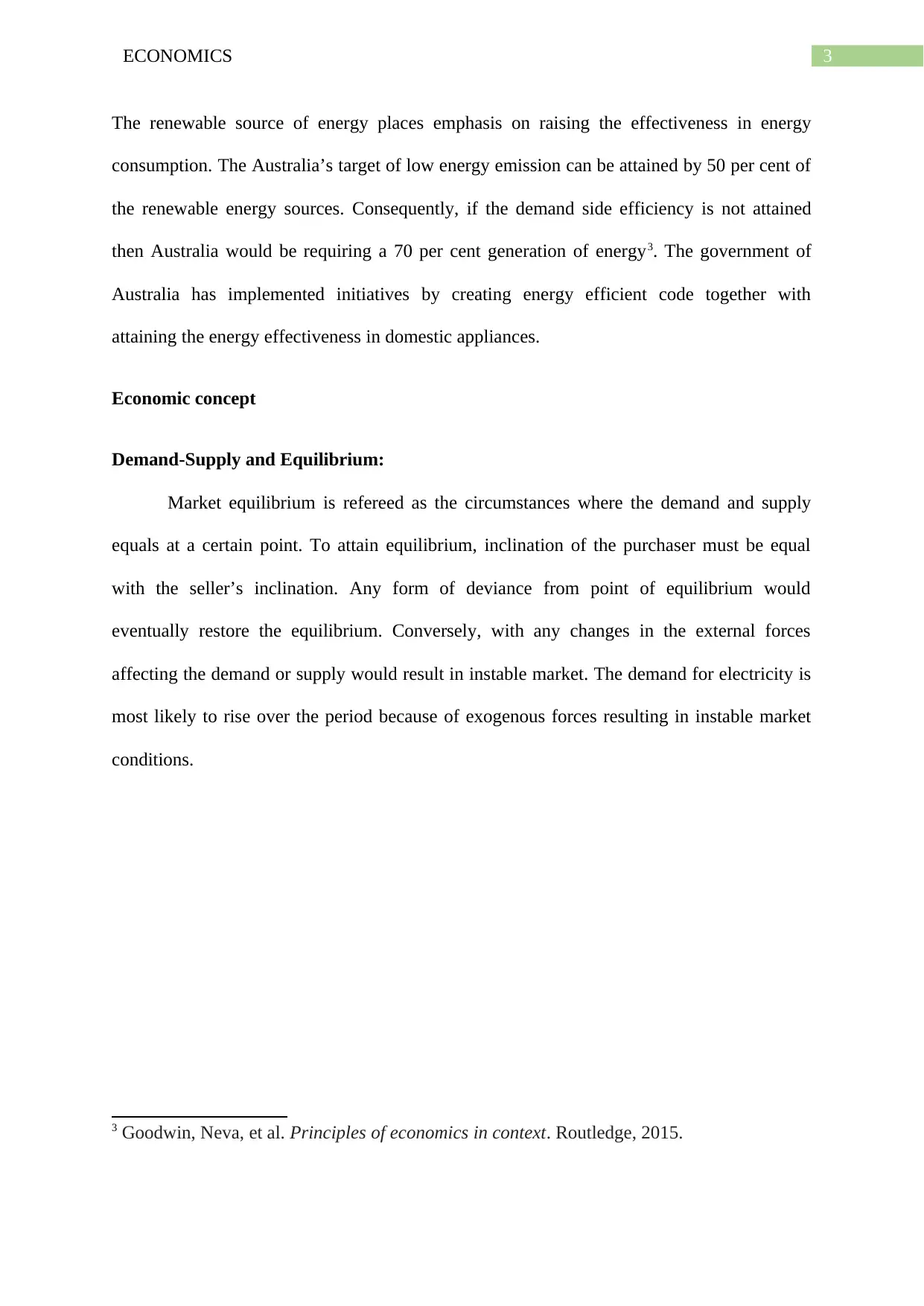
3ECONOMICS
The renewable source of energy places emphasis on raising the effectiveness in energy
consumption. The Australia’s target of low energy emission can be attained by 50 per cent of
the renewable energy sources. Consequently, if the demand side efficiency is not attained
then Australia would be requiring a 70 per cent generation of energy3. The government of
Australia has implemented initiatives by creating energy efficient code together with
attaining the energy effectiveness in domestic appliances.
Economic concept
Demand-Supply and Equilibrium:
Market equilibrium is refereed as the circumstances where the demand and supply
equals at a certain point. To attain equilibrium, inclination of the purchaser must be equal
with the seller’s inclination. Any form of deviance from point of equilibrium would
eventually restore the equilibrium. Conversely, with any changes in the external forces
affecting the demand or supply would result in instable market. The demand for electricity is
most likely to rise over the period because of exogenous forces resulting in instable market
conditions.
3 Goodwin, Neva, et al. Principles of economics in context. Routledge, 2015.
The renewable source of energy places emphasis on raising the effectiveness in energy
consumption. The Australia’s target of low energy emission can be attained by 50 per cent of
the renewable energy sources. Consequently, if the demand side efficiency is not attained
then Australia would be requiring a 70 per cent generation of energy3. The government of
Australia has implemented initiatives by creating energy efficient code together with
attaining the energy effectiveness in domestic appliances.
Economic concept
Demand-Supply and Equilibrium:
Market equilibrium is refereed as the circumstances where the demand and supply
equals at a certain point. To attain equilibrium, inclination of the purchaser must be equal
with the seller’s inclination. Any form of deviance from point of equilibrium would
eventually restore the equilibrium. Conversely, with any changes in the external forces
affecting the demand or supply would result in instable market. The demand for electricity is
most likely to rise over the period because of exogenous forces resulting in instable market
conditions.
3 Goodwin, Neva, et al. Principles of economics in context. Routledge, 2015.
Paraphrase This Document
Need a fresh take? Get an instant paraphrase of this document with our AI Paraphraser
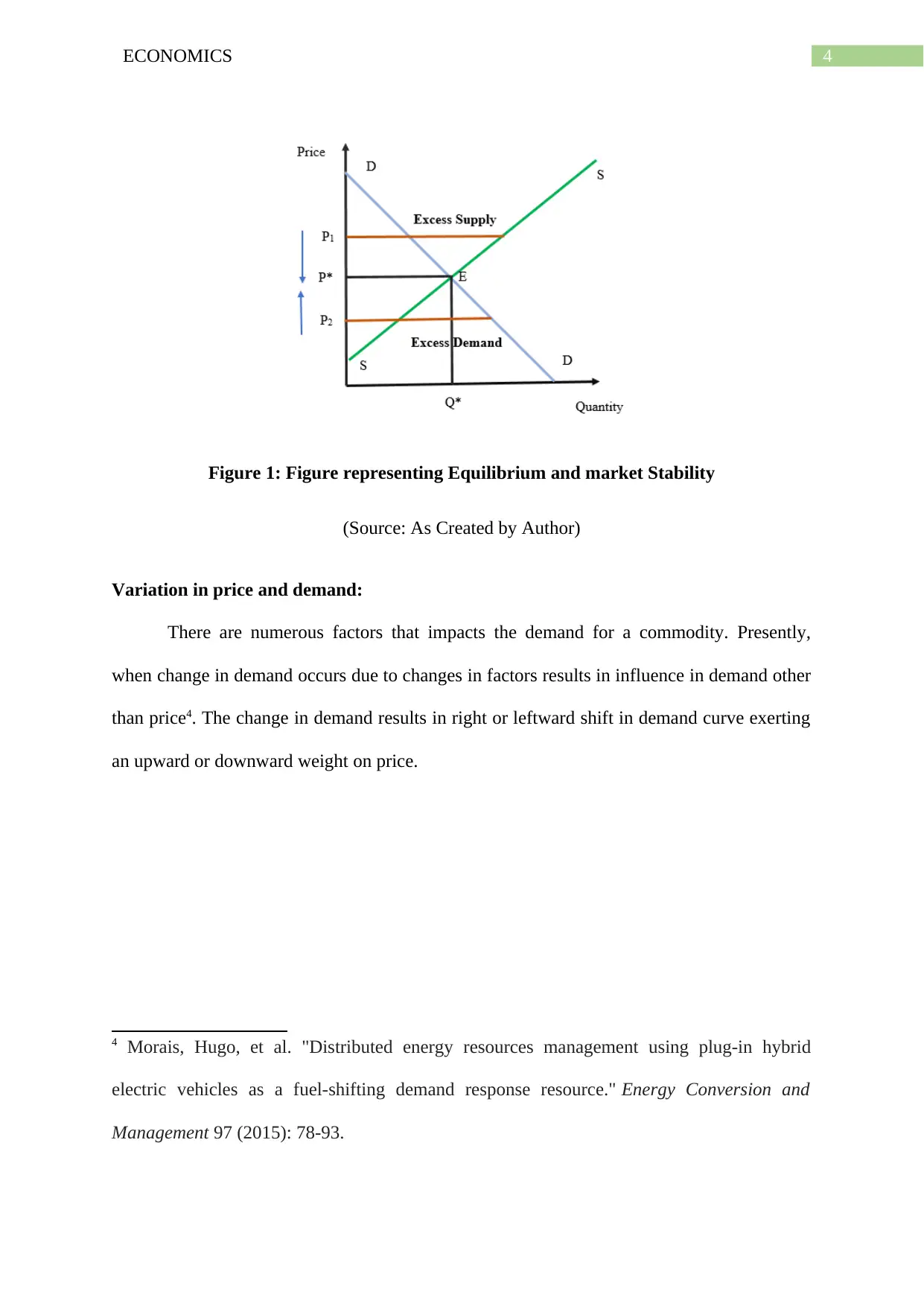
4ECONOMICS
Figure 1: Figure representing Equilibrium and market Stability
(Source: As Created by Author)
Variation in price and demand:
There are numerous factors that impacts the demand for a commodity. Presently,
when change in demand occurs due to changes in factors results in influence in demand other
than price4. The change in demand results in right or leftward shift in demand curve exerting
an upward or downward weight on price.
4 Morais, Hugo, et al. "Distributed energy resources management using plug-in hybrid
electric vehicles as a fuel-shifting demand response resource." Energy Conversion and
Management 97 (2015): 78-93.
Figure 1: Figure representing Equilibrium and market Stability
(Source: As Created by Author)
Variation in price and demand:
There are numerous factors that impacts the demand for a commodity. Presently,
when change in demand occurs due to changes in factors results in influence in demand other
than price4. The change in demand results in right or leftward shift in demand curve exerting
an upward or downward weight on price.
4 Morais, Hugo, et al. "Distributed energy resources management using plug-in hybrid
electric vehicles as a fuel-shifting demand response resource." Energy Conversion and
Management 97 (2015): 78-93.
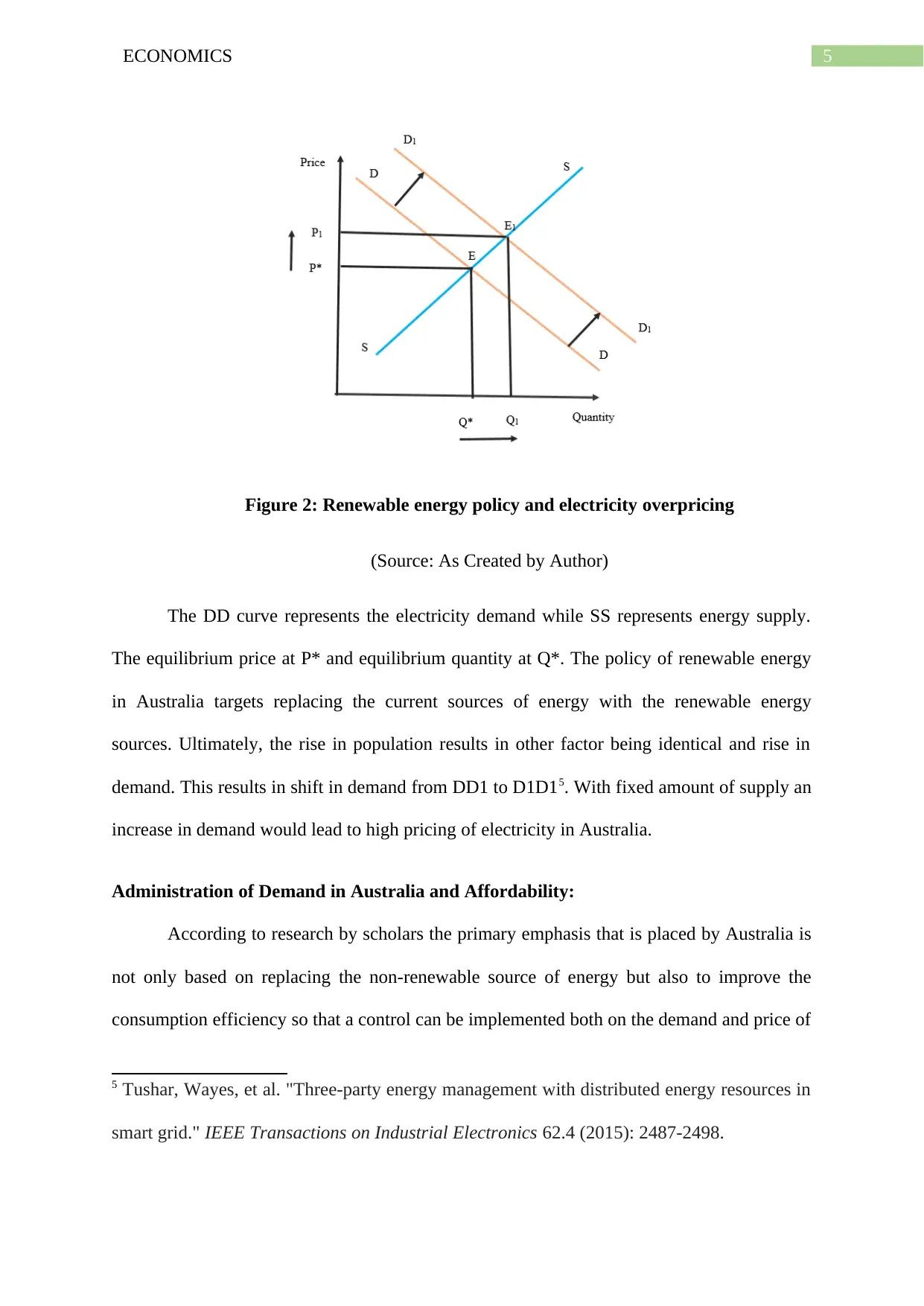
5ECONOMICS
Figure 2: Renewable energy policy and electricity overpricing
(Source: As Created by Author)
The DD curve represents the electricity demand while SS represents energy supply.
The equilibrium price at P* and equilibrium quantity at Q*. The policy of renewable energy
in Australia targets replacing the current sources of energy with the renewable energy
sources. Ultimately, the rise in population results in other factor being identical and rise in
demand. This results in shift in demand from DD1 to D1D15. With fixed amount of supply an
increase in demand would lead to high pricing of electricity in Australia.
Administration of Demand in Australia and Affordability:
According to research by scholars the primary emphasis that is placed by Australia is
not only based on replacing the non-renewable source of energy but also to improve the
consumption efficiency so that a control can be implemented both on the demand and price of
5 Tushar, Wayes, et al. "Three-party energy management with distributed energy resources in
smart grid." IEEE Transactions on Industrial Electronics 62.4 (2015): 2487-2498.
Figure 2: Renewable energy policy and electricity overpricing
(Source: As Created by Author)
The DD curve represents the electricity demand while SS represents energy supply.
The equilibrium price at P* and equilibrium quantity at Q*. The policy of renewable energy
in Australia targets replacing the current sources of energy with the renewable energy
sources. Ultimately, the rise in population results in other factor being identical and rise in
demand. This results in shift in demand from DD1 to D1D15. With fixed amount of supply an
increase in demand would lead to high pricing of electricity in Australia.
Administration of Demand in Australia and Affordability:
According to research by scholars the primary emphasis that is placed by Australia is
not only based on replacing the non-renewable source of energy but also to improve the
consumption efficiency so that a control can be implemented both on the demand and price of
5 Tushar, Wayes, et al. "Three-party energy management with distributed energy resources in
smart grid." IEEE Transactions on Industrial Electronics 62.4 (2015): 2487-2498.
⊘ This is a preview!⊘
Do you want full access?
Subscribe today to unlock all pages.

Trusted by 1+ million students worldwide
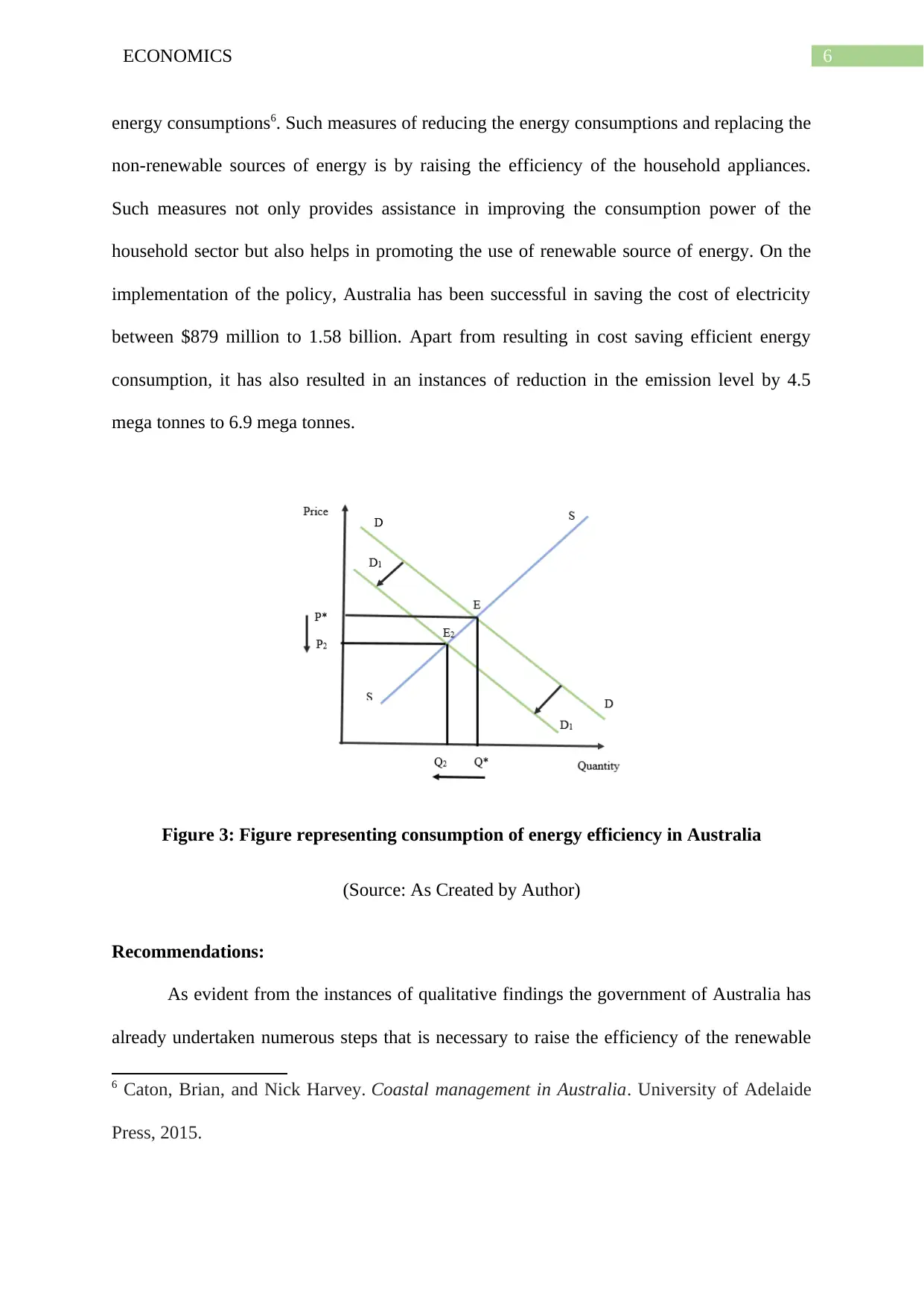
6ECONOMICS
energy consumptions6. Such measures of reducing the energy consumptions and replacing the
non-renewable sources of energy is by raising the efficiency of the household appliances.
Such measures not only provides assistance in improving the consumption power of the
household sector but also helps in promoting the use of renewable source of energy. On the
implementation of the policy, Australia has been successful in saving the cost of electricity
between $879 million to 1.58 billion. Apart from resulting in cost saving efficient energy
consumption, it has also resulted in an instances of reduction in the emission level by 4.5
mega tonnes to 6.9 mega tonnes.
Figure 3: Figure representing consumption of energy efficiency in Australia
(Source: As Created by Author)
Recommendations:
As evident from the instances of qualitative findings the government of Australia has
already undertaken numerous steps that is necessary to raise the efficiency of the renewable
6 Caton, Brian, and Nick Harvey. Coastal management in Australia. University of Adelaide
Press, 2015.
energy consumptions6. Such measures of reducing the energy consumptions and replacing the
non-renewable sources of energy is by raising the efficiency of the household appliances.
Such measures not only provides assistance in improving the consumption power of the
household sector but also helps in promoting the use of renewable source of energy. On the
implementation of the policy, Australia has been successful in saving the cost of electricity
between $879 million to 1.58 billion. Apart from resulting in cost saving efficient energy
consumption, it has also resulted in an instances of reduction in the emission level by 4.5
mega tonnes to 6.9 mega tonnes.
Figure 3: Figure representing consumption of energy efficiency in Australia
(Source: As Created by Author)
Recommendations:
As evident from the instances of qualitative findings the government of Australia has
already undertaken numerous steps that is necessary to raise the efficiency of the renewable
6 Caton, Brian, and Nick Harvey. Coastal management in Australia. University of Adelaide
Press, 2015.
Paraphrase This Document
Need a fresh take? Get an instant paraphrase of this document with our AI Paraphraser
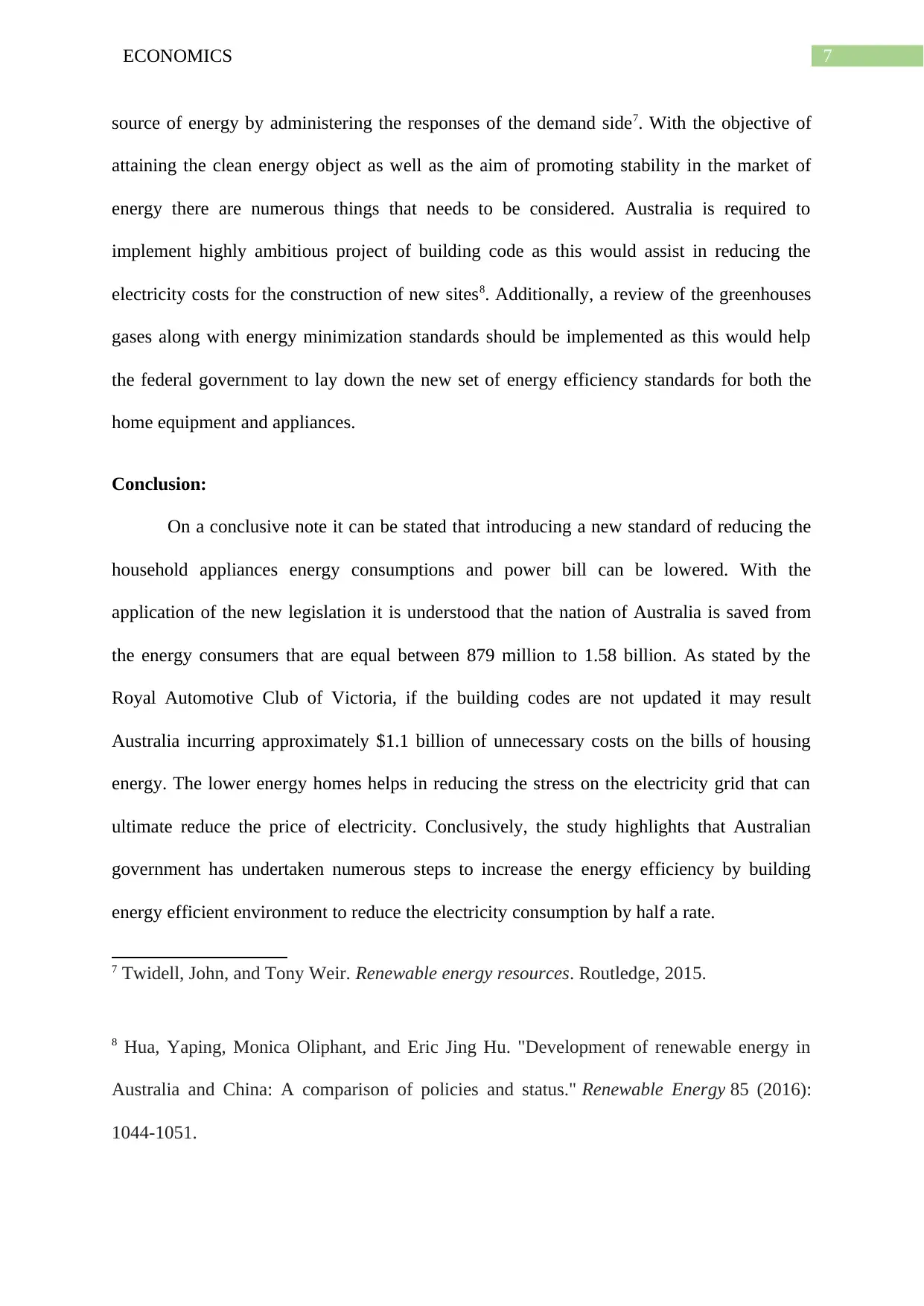
7ECONOMICS
source of energy by administering the responses of the demand side7. With the objective of
attaining the clean energy object as well as the aim of promoting stability in the market of
energy there are numerous things that needs to be considered. Australia is required to
implement highly ambitious project of building code as this would assist in reducing the
electricity costs for the construction of new sites8. Additionally, a review of the greenhouses
gases along with energy minimization standards should be implemented as this would help
the federal government to lay down the new set of energy efficiency standards for both the
home equipment and appliances.
Conclusion:
On a conclusive note it can be stated that introducing a new standard of reducing the
household appliances energy consumptions and power bill can be lowered. With the
application of the new legislation it is understood that the nation of Australia is saved from
the energy consumers that are equal between 879 million to 1.58 billion. As stated by the
Royal Automotive Club of Victoria, if the building codes are not updated it may result
Australia incurring approximately $1.1 billion of unnecessary costs on the bills of housing
energy. The lower energy homes helps in reducing the stress on the electricity grid that can
ultimate reduce the price of electricity. Conclusively, the study highlights that Australian
government has undertaken numerous steps to increase the energy efficiency by building
energy efficient environment to reduce the electricity consumption by half a rate.
7 Twidell, John, and Tony Weir. Renewable energy resources. Routledge, 2015.
8 Hua, Yaping, Monica Oliphant, and Eric Jing Hu. "Development of renewable energy in
Australia and China: A comparison of policies and status." Renewable Energy 85 (2016):
1044-1051.
source of energy by administering the responses of the demand side7. With the objective of
attaining the clean energy object as well as the aim of promoting stability in the market of
energy there are numerous things that needs to be considered. Australia is required to
implement highly ambitious project of building code as this would assist in reducing the
electricity costs for the construction of new sites8. Additionally, a review of the greenhouses
gases along with energy minimization standards should be implemented as this would help
the federal government to lay down the new set of energy efficiency standards for both the
home equipment and appliances.
Conclusion:
On a conclusive note it can be stated that introducing a new standard of reducing the
household appliances energy consumptions and power bill can be lowered. With the
application of the new legislation it is understood that the nation of Australia is saved from
the energy consumers that are equal between 879 million to 1.58 billion. As stated by the
Royal Automotive Club of Victoria, if the building codes are not updated it may result
Australia incurring approximately $1.1 billion of unnecessary costs on the bills of housing
energy. The lower energy homes helps in reducing the stress on the electricity grid that can
ultimate reduce the price of electricity. Conclusively, the study highlights that Australian
government has undertaken numerous steps to increase the energy efficiency by building
energy efficient environment to reduce the electricity consumption by half a rate.
7 Twidell, John, and Tony Weir. Renewable energy resources. Routledge, 2015.
8 Hua, Yaping, Monica Oliphant, and Eric Jing Hu. "Development of renewable energy in
Australia and China: A comparison of policies and status." Renewable Energy 85 (2016):
1044-1051.

8ECONOMICS
⊘ This is a preview!⊘
Do you want full access?
Subscribe today to unlock all pages.

Trusted by 1+ million students worldwide
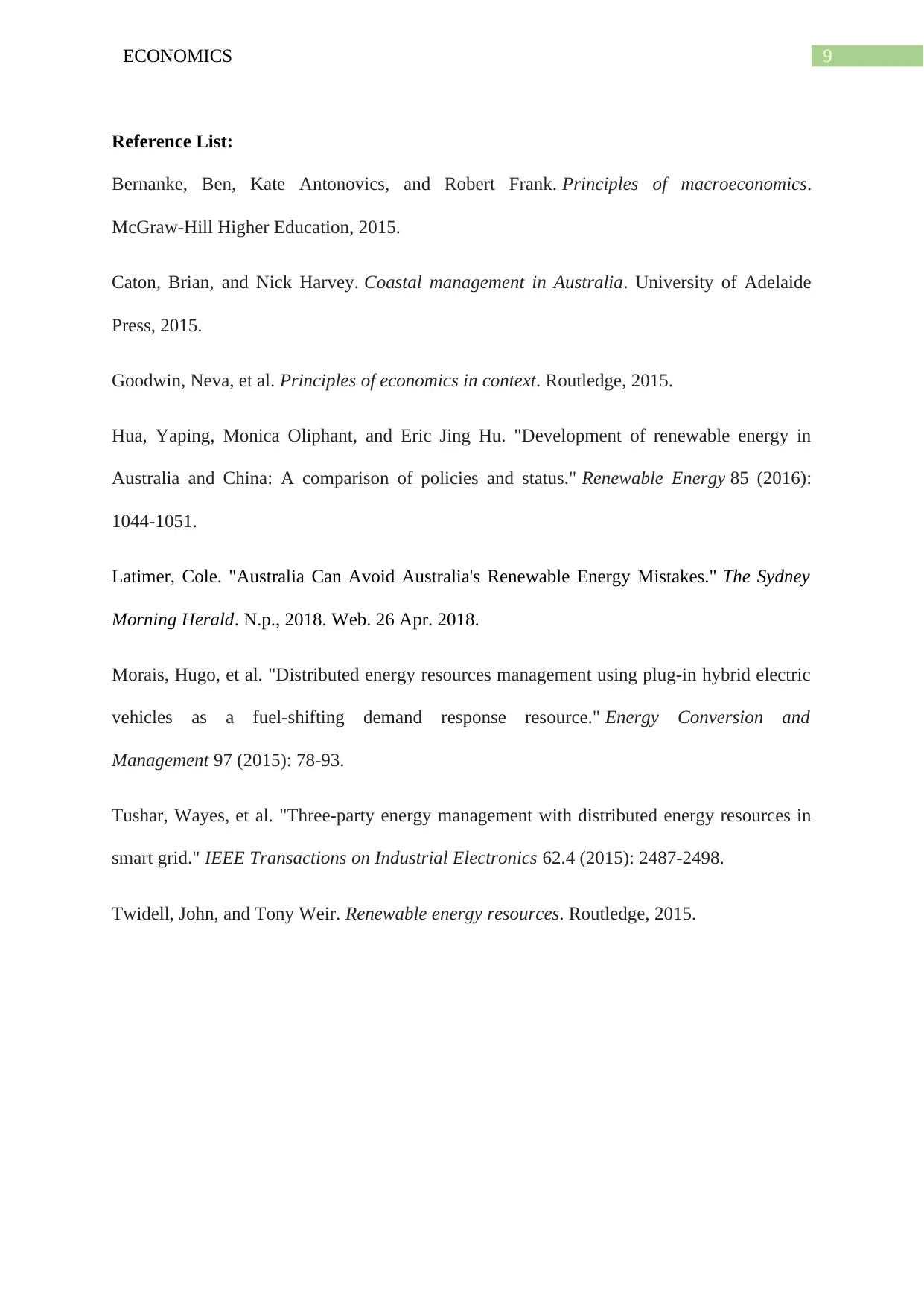
9ECONOMICS
Reference List:
Bernanke, Ben, Kate Antonovics, and Robert Frank. Principles of macroeconomics.
McGraw-Hill Higher Education, 2015.
Caton, Brian, and Nick Harvey. Coastal management in Australia. University of Adelaide
Press, 2015.
Goodwin, Neva, et al. Principles of economics in context. Routledge, 2015.
Hua, Yaping, Monica Oliphant, and Eric Jing Hu. "Development of renewable energy in
Australia and China: A comparison of policies and status." Renewable Energy 85 (2016):
1044-1051.
Latimer, Cole. "Australia Can Avoid Australia's Renewable Energy Mistakes." The Sydney
Morning Herald. N.p., 2018. Web. 26 Apr. 2018.
Morais, Hugo, et al. "Distributed energy resources management using plug-in hybrid electric
vehicles as a fuel-shifting demand response resource." Energy Conversion and
Management 97 (2015): 78-93.
Tushar, Wayes, et al. "Three-party energy management with distributed energy resources in
smart grid." IEEE Transactions on Industrial Electronics 62.4 (2015): 2487-2498.
Twidell, John, and Tony Weir. Renewable energy resources. Routledge, 2015.
Reference List:
Bernanke, Ben, Kate Antonovics, and Robert Frank. Principles of macroeconomics.
McGraw-Hill Higher Education, 2015.
Caton, Brian, and Nick Harvey. Coastal management in Australia. University of Adelaide
Press, 2015.
Goodwin, Neva, et al. Principles of economics in context. Routledge, 2015.
Hua, Yaping, Monica Oliphant, and Eric Jing Hu. "Development of renewable energy in
Australia and China: A comparison of policies and status." Renewable Energy 85 (2016):
1044-1051.
Latimer, Cole. "Australia Can Avoid Australia's Renewable Energy Mistakes." The Sydney
Morning Herald. N.p., 2018. Web. 26 Apr. 2018.
Morais, Hugo, et al. "Distributed energy resources management using plug-in hybrid electric
vehicles as a fuel-shifting demand response resource." Energy Conversion and
Management 97 (2015): 78-93.
Tushar, Wayes, et al. "Three-party energy management with distributed energy resources in
smart grid." IEEE Transactions on Industrial Electronics 62.4 (2015): 2487-2498.
Twidell, John, and Tony Weir. Renewable energy resources. Routledge, 2015.
1 out of 10
Related Documents
Your All-in-One AI-Powered Toolkit for Academic Success.
+13062052269
info@desklib.com
Available 24*7 on WhatsApp / Email
![[object Object]](/_next/static/media/star-bottom.7253800d.svg)
Unlock your academic potential
Copyright © 2020–2025 A2Z Services. All Rights Reserved. Developed and managed by ZUCOL.



